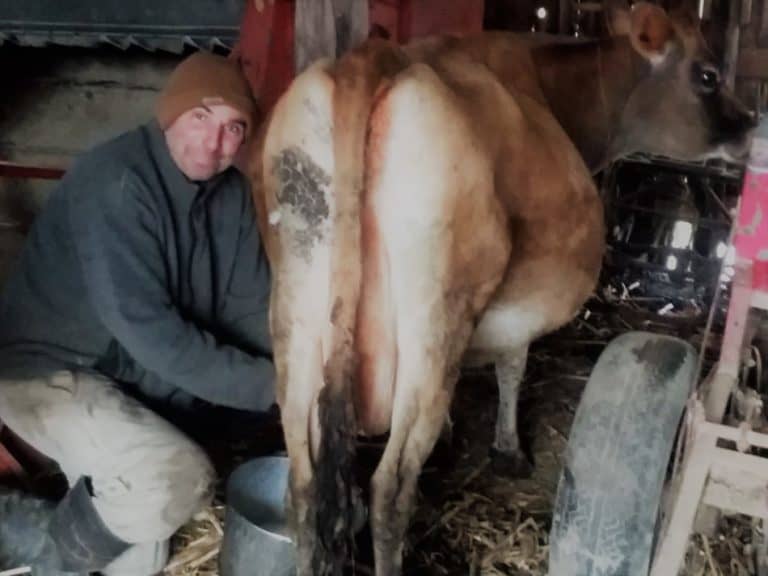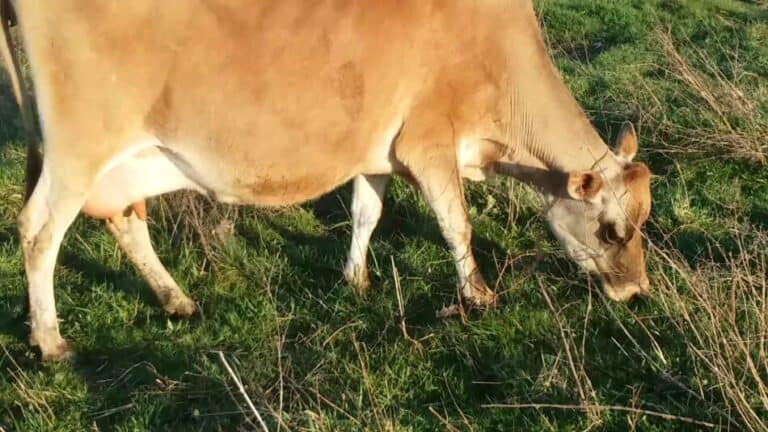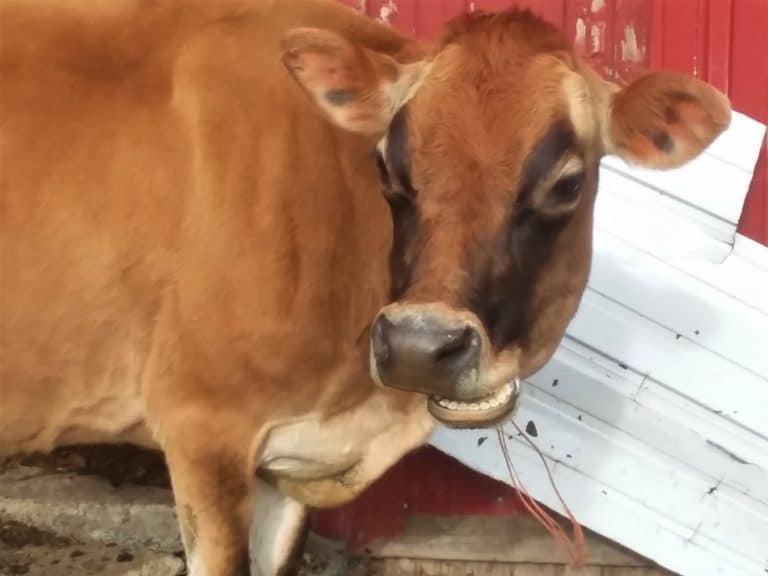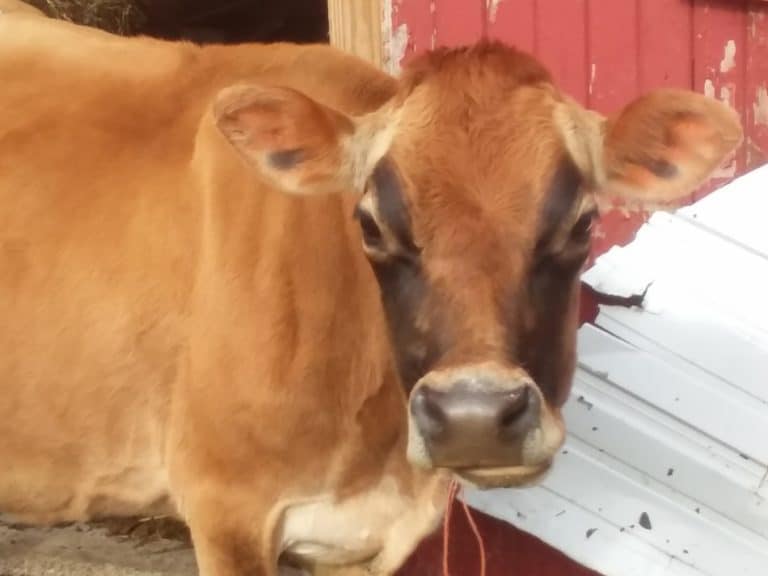Need A Family Cow? 12 Breeds You Should Know
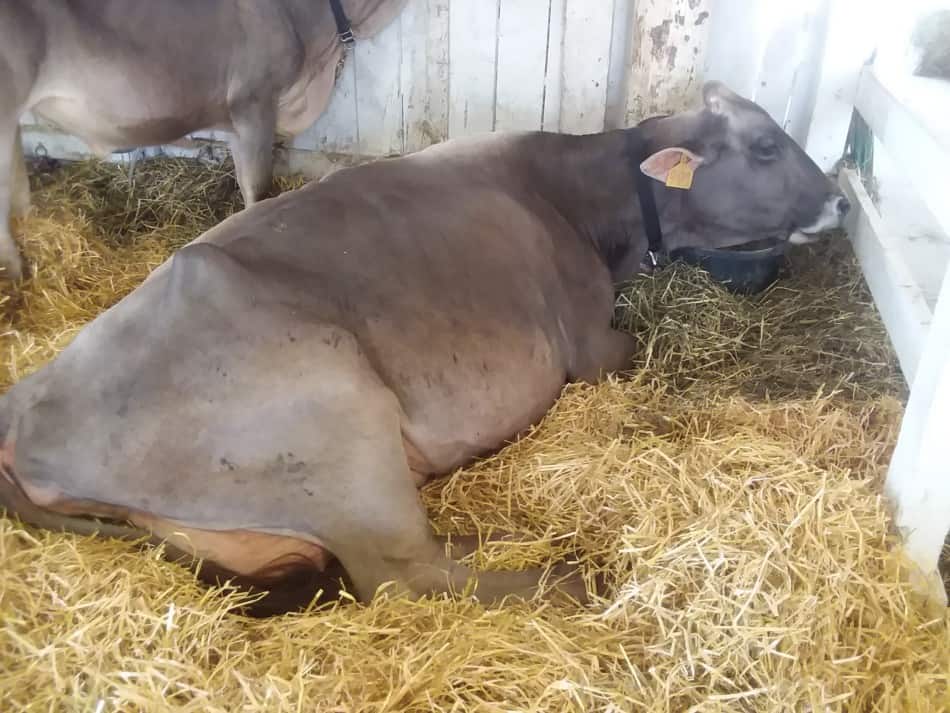
Thinking of getting your own cow? Fresh milk from your own cow is wonderful! It’ll ruin you for store milk, seriously.
Your cow’s milk and store milk are not even on the same planet when you consider taste or nutrition.
12 dairy cattle breeds in the United States are: Holstein, Brown Swiss, Ayrshire, Guernsey, Jersey, Milking Shorthorn, Dutch Belted, Milking Devon, Normande, American Lineback and Dexter.
How do you know if you’re ready? My guide “Are You Ready For A Family Cow?” will walk you through the things you need to have figured out, including feeding needs and daily care, before you get your cow.
If you are looking for a shorter list, you know, just the best, consider reading Family Milk Cow 5 Best Breeds, where you’ll get the short list of my top contenders!
| Breed | Family cow potential | Main characteristic |
| Holstein | low (production too high) | high milk yields |
| Brown Swiss | high | calm cow |
| Ayrshire | high | hardy cow |
| Guernsey | high | easy to get along with |
| Jersey | high | most popular |
| Milking Shorthorn | low (hard to find) | traditionally bred cows are hardy |
| Dutch Belted | low (not beginner cow) | unique markings |
| Milking Devon | low (rare) | colonial breed |
| Normande | low (rare) | great for cheese |
| American Lineback | low (rare) | hard to find |
| Dexter | medium (must be from dairy focused herd) | smaller framed cow |
| Crossbred | high | great family cow choice |
Here are 12 breeds, some common some, more rare, of dairy cattle found in the U.S.
I have included my comments on the breed under the Homestead potential section.
12 Dairy Cattle Breeds to consider
We (my husband and I) have hands on experience with the majority of the breeds on the list.
Most of these dairy breeds we have owned. Holstein and Guernsey cattle experience comes from helping out other farmers we know.
If we don’t know anything about the breed first hand, then I point that out as well.
The Holstein is a milk machine
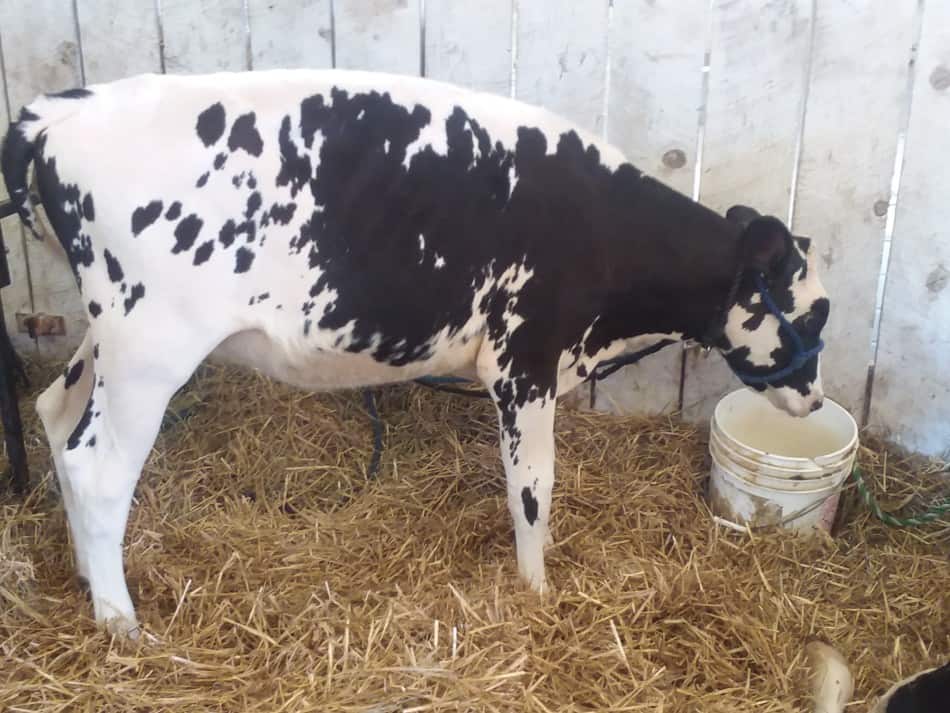
Homestead potential? Low. Her crime? She’s too good of a milker! Holsteins are great cattle, but they are going to produce way more milk than you can use.
The Holstein is the most popular commercial dairy cow in the U.S. As far as milk production goes she is untouchable.
These gals are originally known as Holstein-Friesian being a combination of the cows from the province of Friesland in the Netherlands and the Holstein region of northern Germany.
Holsteins are larger sized, black and white cattle often weighing 1500 pounds. Her milk will be around 3.9% fat and 3.2% protein.
Holstein cows will average 23.713 pounds of milk per lactation. Fluid milk production is measured in pounds with eight pounds to the gallon.
So if you do the math here that is:
23,713 pounds of milk divided by a 305 day lactation =77.75 pounds of milk per day (we’ll round up to 78 pounds per day)
78 divided by 8 pounds per gallon =9.7 gallons of milk per day!
If you are looking into a family cow that is a lot of milk!
Generally speaking, most Holsteins will need at least some supplemental feed in addition to grass in order to keep on body weight, support a pregnancy and provide milk for you.
There is an exception here: A Holstein that is a sweetheart but too low of a producer for a commercial dairy is a possibility for a family cow.
What To Feed Your Family Cow goes over the nutrition needs of your favorite milk maker!
Brown Swiss are gentle
Homestead potential? Very high, if you have the space and feed for a bigger cow. Brown Swiss are wonderfully calm cattle, I love them. And they produce a good size calf!
The Brown Swiss is the oldest purebred dairy breed first imported to the U.S. in 1869.
Brown Swiss cattle are bigger boned with a larger frame than any other breed. This is a very substantial cow!
Brown Swiss come in a solid color ranging anywhere from grey to brown body color with black nose, tongue, hooves and tail hair.
Brown Swiss are docile, hardy cattle that graze well.
Being heavier bodied than most other dairy breeds, Swiss produce nice size calves to feed out as well. She will be a large cow weighing 1600 pounds.
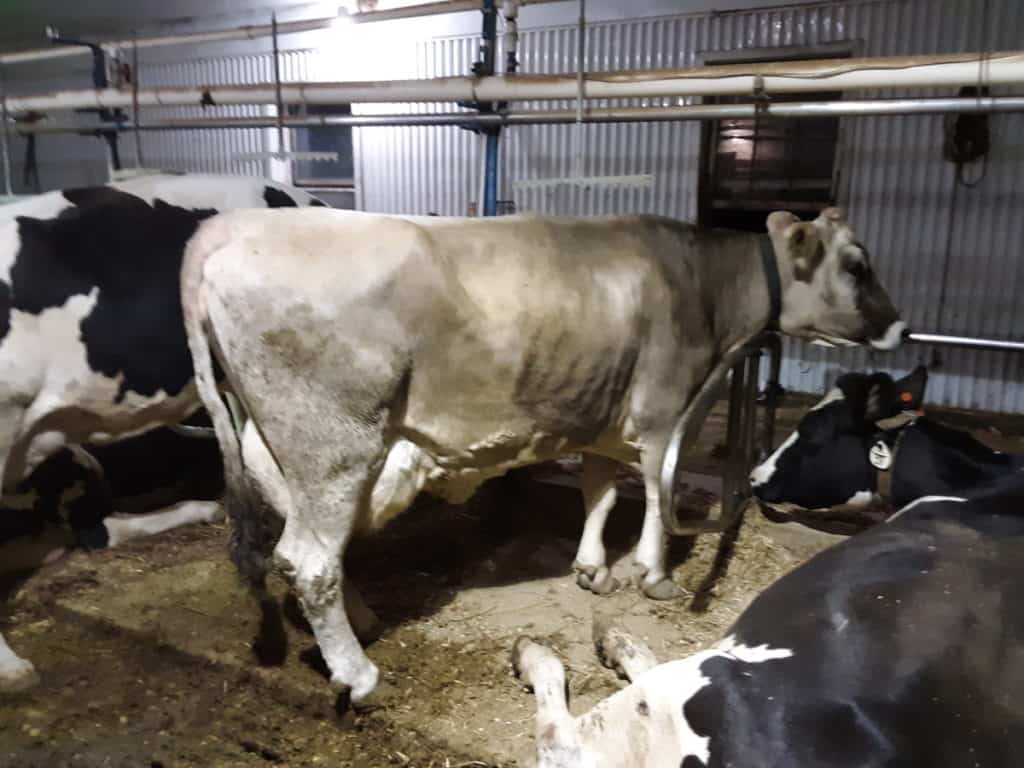
Brown Swiss are bigger and longer than all other dairy breeds except for Holstein.
If you had a smaller breed cow before and are switching to Brown Swiss be aware she will need more space in the barn and in the milking stall. Well worth it -these are great cows!
Swiss have a higher component milk with 4.2% fat and 3.7% protein. Her total pounds for the year will be around 19,387.
These gals are very gentle and mild cattle. We had a Swiss named Twinkie in with our Jerseys.
We were concerned she might be pushy with the much smaller Jersey cows. Actually, it was the other way around!
The Jerseys liked to bother Twinkie but she would just ignore them by acting like they didn’t exist!
Ayrshires are hardy grazers
Homestead potential? Very high. Great choice, hardy and productive cows.
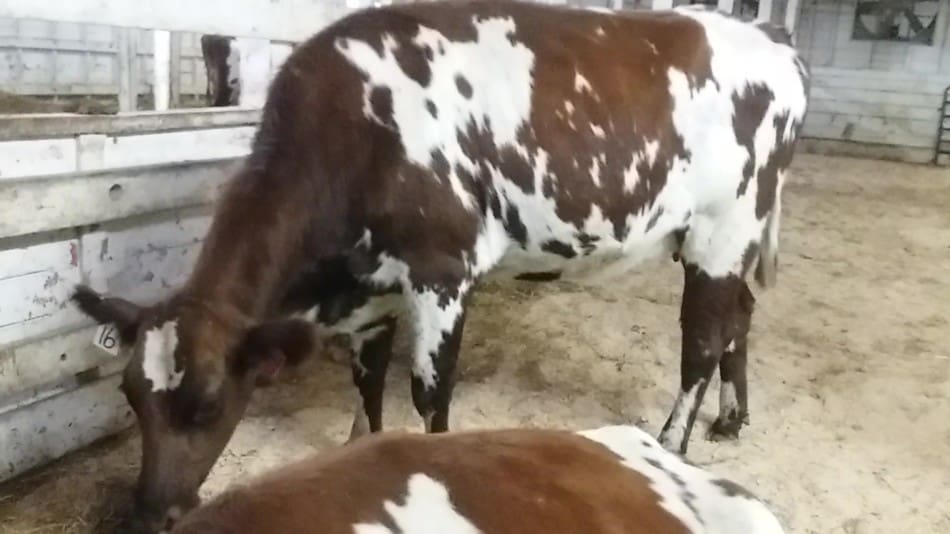
The Ayrshire is from Scotland in the county of Ayr first coming to the U.S. in 1822.
As with all animals from harsher climates the Ayrshire is bred to handle less abundant forages.
She is a red and white cow that can vary from nearly all red or all white to quite patchy but clearly defined colors-my favorite color pattern.
Ayrshires will reach 1200 pounds body weight and will milk 17,807 pounds of 4.1% fat and 3.4% protein milk per lactation.
These cattle are known to be hardy and good grazers.
Daily Care For Your Family Cow goes over the few things your cow needs to be happy and productive.
How do you know if you’re ready? My guide “Are You Ready For A Family Cow?” will walk you through the things you need to have figured out, including feeding needs and daily care, before you get your cow.
Guernsey have a wonderful attitude
Homestead potential? Very high. Calm, friendly cows. My husband wants a Guernsey for our next family cow.
The Guernsey cow is originally from the Channel Islands, specifically the Isle of Guernsey, that are off the coast of France.
Guernseys came to the U.S. in 1831 and were the most popular dairy breed by far for decades.
Golden Guernsey Milk was this breed’s main selling point-the golden part comes from the high beta carotene in the butterfat giving the milk a gold like color.
Guernseys are a light brown and white spotted cow weighing 1200 pounds. She will produce 16,290 pounds of milk with 4.8% fat and 3.5% protein.
The Guernsey is a gentle, fast maturing breed that grazes well.
Jersey has rich milk
Homestead potential? Very high. We have a Jersey.
She produces tons of milk on grass alone (3-4 gallons per day, no grain, milking one month) and reliably breeds back.
And she’s old-14 is our best guess, we lost track!
Next we have the Jersey. She is a cute smaller cow with large eyes and a dished face.

Jersey cattle are from the Channel Islands (like the Guernsey cow)-this time the Isle of Jersey. Jerseys are an old breed that came to the U.S. around 1815.
Jersey cows are popular because of their high butterfat milk. This is the main breed we milked and the breed of our current family cow.
Jerseys are great grazers, friendly and tend to have an easier time calving than larger dairy breeds.
Most Jerseys will be at 1000 pounds or less of body weight making them the smallest of the recognized (major) dairy breeds.
These cattle come in a variety of colors some spotted some solid ranging from light brown to almost black.
The classic Jersey look is a fawn brown body with darker coloring of the head, legs and tail.
Jersey cattle are still popular on dairy farms today because of their high component milk.
Components are the nutrients in the milk that are not water- mainly fat and protein, that you get paid for in your milk check.
Higher components equals more money per pound of milk.
Jerseys will milk around 15,593 pounds per lactation with 5.1% fat and 3.8% protein.
Our Jersey gets grass or hay (no grain) and still produces 3 gallons or so per day.
Milking Shorthorn is hardy
Homestead potential? Very high. Milking Shorthorns are hardy, reliable cows.
The Milking Shorthorn is a dairy cattle breed from England near the Scottish border.
Milking Shorthorn and the Shorthorn (a beef breed) started off as the same breed.
They were selected for either milking traits or carcass traits and kept as separate breeds for quite some time now-the breeding lines were originally separated in the 1700’s.
Milking Shorthorns are red and white cattle ranging from nearly all white to all red to a mix called roan.
I love the dark red roan cows they are truly sharp looking gals.
They will reach 1200 pounds at maturity. Cows average 15,450 pounds per lactation with 3.9% fat and 3.3% protein.
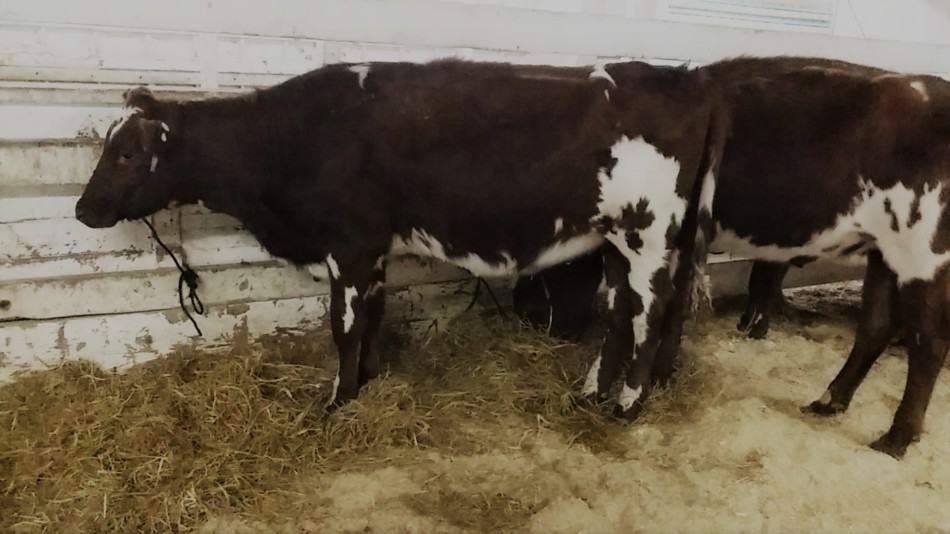
The Milking Shorthorn is a good grazer, fertile, and hardy.
We have had a few of these cattle and for the most part they are a good take care of herself kind of cow.
Some have more dairy character (thinner build) than others but usually milking shorthorns are a sturdier cow that will have nice sized calves that would do great fed out as a steer.
If you are interested in a Milking Shorthorn, you should know the herd book has opened up to allow red genetics that are not Milking Shorthorn to be used in the pedigreed cattle.
This means that your Milking Shorthorn cow could easily be part Red Holstein!
That’s not a problem, but it will result in a higher producing cow that is closer to a Holstein than a Milking Shorthorn in performance.
Before you buy, ask if the breeder has been using anything other than 100% Milking Shorthorn genetics.
If they have, this cow may not have the hardiness that you are expecting to find in a more traditional type Milking Shorthorn.
Dutch Belted is eye catching
Homestead potential? Maybe. If you have cattle experience, sure. If you are a total beginner, no-choose a calmer breed for your first family cow. Great cow, but has too much energy for a beginner.
The Dutch Belted or Lakenvelder is from the Tyrol areas of Switzerland and Austria.
The name Dutch Belted comes from the white belt that goes completely around their body and that they were brought to the U.S. after being noticed in Holland where they were very popular at the time.
The Dutch Belted cattle are black on both front and back ends with a wide white belt going around the middle.
Dutch Belted cows weigh 1100 pounds and produce 12,000 pounds of milk per lactation. This is a rare breed with low numbers in the U.S.
That being said of the more unusual breeds listed the Dutch Belted has a higher milking potential than most of the other rare breeds.
We had some Dutch Belted that we kept in the herd when we milked cows for a living and they did as good as any of the more common dairy breeds provided they were fed as needed to produce more milk.
The Dutch Belted cow is a good grazer, fertile and easy calving.
How do you know if you’re ready? My guide “Are You Ready For A Family Cow?” will walk you through the things you need to have figured out, including feeding needs and daily care, before you get your cow.
Additionally this breed seems to cross well with other dairy breeds producing a versatile belted cross.
If you have some dairy cattle experience, Dutch Belted cattle are great. Dutch Belted cross cattle are wonderful, as well.
If you do not have any dairy cattle experience, start with another breed for your first cow and go with a Dutch Belted cow next time.
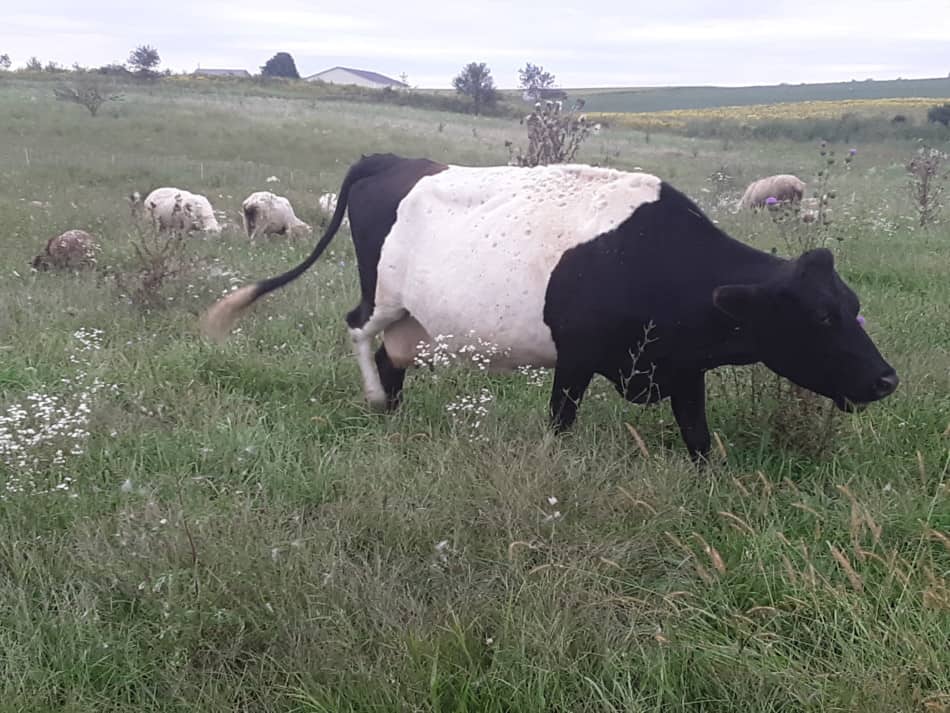
Milking Devon were colonial cattle
Homestead potential? No personal experience with Milking Devon, however, (going off of the information I have been able to find) I would be happy to have one as a family cow.
The Milking Devon is from Devon, England where it was kept as a triple purpose breed providing meat, milk and draft all in one breed!
Milking Devons were brought to the colonies with the Pilgrims beginning in 1623.
These cattle are red- anywhere from dark to light occasionally having a white udder or tail and have white horns with a black tip.
Milking Devons weigh 1100 pounds and produce rich milk with no grain.
These cattle have a compact body, square set legs, and good udder structure.
Milking Devon is the original low maintenance, hardy cow for America.
They are also a popular breed choice for farmers looking to raise a team of oxen.
As I mentioned above, when we need another cow, I would definitely consider a Milking Devon, if we could find one!
For more information on Milking Devon, check out The Livestock Conservancy-Milking Devon Cattle, they are a wonderful source for information on unusual breeds of livestock.
Normande is a cheese superstar
Homestead potential? Very high. When we look for another cow, I hope to get a Normande.
The Normande is a dual purpose cow, bred for meat and milk, from Normandy, France.
She is red and white with speckles and stripes-called brindle.
These cattle can not be imported.
Any Normande here is from an imported embryo or is bred up in an upgrading plan by using Normande semen on a dairy cow and keep using Normande each generation until nearly 100% Normande is reached.
Normande cows weigh 1300 pounds and produce 14,000 pound of 4.4% fat and 3.65 protein milk per year.
Normande milk has higher casein levels making it ideal for cheese making since it produces 15-20% more cheese per pound of milk than other dairy breeds.
Normandes are an attractive package-calving ease, good grazers, high fertility, and good feed conversion.
American Lineback is unusual
Homestead potential? Maybe. Make sure she was raised as a dairy animal.
The American Lineback is an unusually colored cow having a solid colored body with a speckled edge line of white from the top of the head all along the back and down the tail.
The base body color can be black, red, or roan or have patches of one color on a contrasting color background.
American Lineback weighs 1,000 to 1,500 pounds and will produce 12,000 to 15,000 pounds of 3.5% fat and 3.8% protein milk per year.
Dexter is a small cow
Homestead potential? Maybe. Make sure she was raised as a dairy animal.
The Dexter is the smallest dairy breed weighing in at 700 pounds and standing about 40 inches tall.
Dexters are originally from Ireland. They are most commonly black in color but can also be red.
These small cows produce 8,000 pounds of milk per year with 4-5% fat and 3.5% protein.
Dexters are primarily grazers and do well with minimal barn space.
I have seen a few of these and would caution you to be sure the farmer you are purchasing your cow from raises his/her cows as dairy animals.
All of the Dexters I have seen are cute but they are being raised only as beef animals.
That is perfectly fine but doesn’t suit your purposes if you want a dairy cow!
The other concern I have is when I spoke to the breeders (granted this was just one farm) all they talked about was short legs not fertility, growth, conformation for longevity just short legs.
That is not a good choice of a trait to focus on when other factors are much more important to the health of the animal and the health of the breed.
If you ask how the breeder is making breeding selection decisions and the answers are cosmetic reasons, please look somewhere else for your cow.
Crossbreds are great family cows
Homestead potential? Very high! Chances are good to get a great, hardier than most cow with a more reasonable price than a purebred
The Crossbred is not a specific breed, but a combination of two or more breeds put together to get the outstanding traits from the parent breeds all in one cow.
Crossbreds are great cows that will do everything for you a purebred will do and actually be a bit more hardy and adaptable than a purebred.
Crossbred cattle will also be more affordable than a purebred, especially once you start looking at the rare dairy breeds.
The obvious drawback of a crossbred is that if you want to raise purebred livestock she is not purebred.
However, you always have the option of grading up by consistently using the same breed of bull on each generation so each calf is more genetically than the previous generation.
Right now we are using Angus ( a beef breed) to breed our Jersey cow.
We are getting way more milk than we need from the Jersey so we cross with a beef sire to get more hardiness and a sturdier body in the calves.
So far, we have a nice looking steer (castrated male) able to take care of himself with no grain and this year’s heifer (young female) calf who is doing well, growth wise.
A family cow turns grass to milk
Dairy cattle are kept on farms all over the world because of the cow’s ability to convert renewable and regenerative feed sources like grasses into milk.
We, as eaters with a simple stomach, need some help here because our digestive system cannot use the tough plant fibers in grasses and hay.
Why Does A Cow Eat Grass is an article I wrote explaining more about the cattle digestive system if you want to learn more.
How do you know if you’re ready? My guide “Are You Ready For A Family Cow?” will walk you through the things you need to have figured out, including feeding needs and daily care, before you get your cow.
People can’t eat grass, but grass builds soil
What do we do? Having land in pasture is great for the soil life, builds organic matter and eliminates erosion (all great stuff!) but we can’t eat that grass!
We do what people have done for centuries-let animals harvest the land for us.
This way instead of us gathering 120 plus pounds of grass per day (that we couldn’t eat anyway) we take care of one cow she eats the forage and we “gather” the milk.
Looking around you will see there are lots of breed choices for dairy cattle.
Once you and your family decide to start doing more to produce your own food and get a few of the smaller things done like chickens or a garden it might be time to step up your game and try a cow of your own.
There are many more dairy breeds worldwide that I did not put on this list.
I only included animals that if you live in the U.S. you can find these breeds or cross breed your cow to one of these breeds using A.I. (artificial insemination)
Cautions required before buying a cow
A few words to the wise:
1. If you have zero or very little livestock experience please start with smaller animals and work up to cattle. Cattle are wonderful animals to be around but not a wise choice as a first animal project for a total beginner.
2. When looking into getting your first cow (or any animal) make sure the farm you get her from has the same priorities as you do and is managing their animals in the way you want to manage yours. For example, if you want an easy calving cow don’t get her from a farm that has 24 hour monitoring to pull calves (during a difficult birth) unless you are going to do that as well.
3. Make sure the selection criteria for the breed are for attributes that make sense. For example selecting for short legs is a poor choice. Whereas, selecting other traits like longevity, calving ease, and/or being a docile easy to get along with animal are very important to you and to maintaining the quality of the breed so are excellent logical and meaningful criteria.
How do you know if you’re ready? My guide “Are You Ready For A Family Cow?” will walk you through the things you need to have figured out, including feeding needs and daily care, before you get your cow.
Resources: Canadian Dairy Information Center 2017 Dairy Breeds Comparison Chart; The Family Cow Handbook: A Guide To Keeping A Milk Cow by Philip Hasheider
Related Questions
Which cows give milk?
All breeds of cows of give milk once they have a calf. Dairy breeds are cows that have been selected over generations to produce more milk than a beef breed.
Which is the highest milk producing breed of cow?
The Holstein produces the most milk per year compared to any other breed of dairy cow. Holsteins are also the most popular breed of dairy cattle in the U.S.
